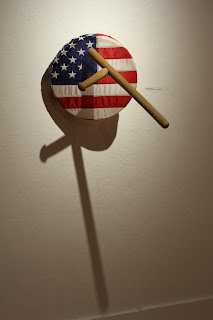 It's time to go beyond buckskin and take a look at some armor. In many Native communities, specialty armor was constructed to provide physical protection on the battlefield. Oftentimes this armor was imbued with spiritual protection as well. These symbolic qualities were viewed as being even more powerful than the physical aspects.
It's time to go beyond buckskin and take a look at some armor. In many Native communities, specialty armor was constructed to provide physical protection on the battlefield. Oftentimes this armor was imbued with spiritual protection as well. These symbolic qualities were viewed as being even more powerful than the physical aspects.One of the coolest examples of Native American warrior gear is Tlingit armor. Tlingit warriors wore battle helmets depicting crest animals or ancestors, along with wooden visors, thick leather tunics, and body armor covered with wooden slats or coins. This battle attire combines technology, ingenuity, and symbolic power and protection.
The walrus-hide body armor (left), which dates from 1800-1830, is covered with Chinese coins. The Tlingit obtained these items through trade, and stories are told among the Northern Tlingit of having access to goods from the Pacific region even prior to the arrival of Europeans.
Academics sometimes suggest that the use of coins may have been an attempt to create bulletproof armor after the introduction of firearms. Russian accounts from the late 1700s attest to the protective power of such armor - at least in psychological warfare - and some described how their bullets were useless against Tlingit armor.
The coins of this moose-hide warrior shirt (above left) were sewn on using sinew, creating a chevron pattern. The design is reminiscent of the powerful rib motif seen on valuable copper shields and important shamanic art of this region. While the pattern leaves vulnerable spots of the chest unprotected, the references to the rib design suggest that the efficacy of this armor lay in its ceremonial or ritual power.
The sketch (above right) is of a Tlingit warrior wearing a helmet, and neck and body armor (redrawn from an original made in 1791). Although not metal, the wooden slats, paired with thick leather, could easily deflect arrows to the chest.
Recently, multi-media artist Nicholas Galanin (Tlingit/Aleut) incorporated imagery of Tlingit armor in his solo exhibition, Things Are Looking Native, Native's Looking Whiter, held at the Bunnell Street Arts Center in Homer, Alaska. One of the works in the show was a direct response to the murder of Nuu-Chah-Nulth wood carver John T. Williams by a police officer.
In a two-part installation piece, Galanin created a drum (made with an American flag) and drum stick (in the shape of a billy club), called, My Ears Are Numb. The title of the piece references the fact that the carver who was killed was partially deaf.
Galanin paired this set with a short video titled How Bout Those Mariners (above right). It features a man clothed in Tlingit armor walking towards the camera. The audio for this video installation comes from the Williams' murder YouTube clip where we hear the radio in the police car during the shooting. About the video, Galanin explains, "The background radio noise discusses the Mariners game, it also references the ability for society and the justice system's ability to sweep this entire event under the god damn carpet." Through this piece, Galanin confronts the numbness of society, and references the old ritual power of Tlingit armor and protection.
[Click here to see more of Galanin's work. Click here , here, or here, to read more about Tlingit armor.]




